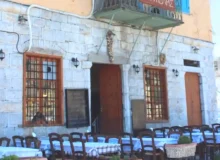Benaki Museum
Athens’ Benaki Museum is one of the city’s top museums with an outstanding collection, especially of Greek and Egyptian artefacts, in a beautiful mansion.

The Benaki Museum, nestled in the heart of Athens, Greece, stands as a pivotal cultural institution, offering visitors a rich and comprehensive journey through the country’s vibrant history and artistic heritage, while also extending its gaze to neighboring cultures.
History of the Benaki Museum
Founded by Antonis Benakis in 1930, the museum was originally housed in the family’s neoclassical mansion on Vasilissis Sofias Avenue. Benakis, a passionate collector and philanthropist, envisioned a museum that would not only showcase Greek art and culture but also serve as a bridge between East and West, reflecting Greece’s unique geographical and historical position.
Main Benaki Museum Building
The main building on Vasilissis Sofias Avenue remains the museum’s central hub and houses its most extensive collection, tracing the evolution of Greek civilization from the prehistoric era to the 20th century. This core collection is meticulously organized, guiding the visitor through millennia of history and artistic expression.
The journey begins with artifacts from the Prehistoric period, including Neolithic pottery and tools, offering glimpses into the earliest settlements and cultures that flourished on Greek soil.
Moving forward, the collection delves into the Ancient Greek period, featuring exquisite examples of pottery, sculpture, and metalwork from the Geometric, Archaic, Classical, and Hellenistic eras. These pieces not only demonstrate the technical mastery of ancient craftsmen but also provide invaluable insights into the daily life, beliefs, and societal structures of ancient Greece.

In the Benaki Museum in Athens
The Roman and Byzantine Periods
The Roman period in Greece is also well-represented, illustrating the cultural exchange and continuity that characterized this era. The collection transitions seamlessly into the Byzantine period, a cornerstone of the Benaki Museum’s holdings. Here, visitors can admire a stunning array of icons, manuscripts, textiles, and decorative arts that reflect the spiritual depth and artistic sophistication of the Byzantine Empire. T
he collection highlights the enduring legacy of Byzantine art and its profound influence on subsequent artistic developments in the region. Following the fall of Constantinople, the museum’s exhibits explore the Post-Byzantine period, showcasing the resilience of Greek culture under Ottoman rule. This section features religious art, folk costumes, and everyday objects that speak to the preservation of Greek identity and traditions during this challenging time.
Greek War of Independence

In the Benaki Museum in Athens
The journey continues into the Neo-Hellenic period, covering the years leading up to and following the Greek War of Independence in 1821. This part of the collection includes historical artifacts, portraits of national heroes, and examples of the emerging artistic styles that reflected Greece’s newfound independence and its connection to Western European movements.
20th Century Exhibits
Finally, the main building’s collection concludes with exhibits from the 20th century, featuring paintings, sculptures, and other artworks by prominent Greek artists, bringing the narrative of Greek art and history up to more recent times. The breadth and depth of this collection make the main Benaki Museum an essential starting point for understanding the multifaceted tapestry of Greek culture.
Benaki Museum Outposts
Beyond its central location, the Benaki Museum has expanded its reach through a network of satellite galleries and museums, each dedicated to specific collections or themes. This decentralized structure allows the museum to showcase its diverse holdings more effectively and provide more focused visitor experiences.
Benaki Museum of Islamic Art

Among these outposts, the Benaki Museum of Islamic Art stands out as a particularly significant institution, highlighting the rich cultural interactions between Greece and the Islamic world throughout history.
Housed in a beautifully restored neoclassical building in the historic Kerameikos area of Athens, the Benaki Museum of Islamic Art is a testament to the artistic achievements of Islamic civilizations from the 7th to the 19th centuries.
The collection, one of the most important in the world, spans a vast geographical area, including regions from Spain and North Africa to the Middle East, Persia, and India. The exhibits are arranged chronologically and thematically, guiding visitors through the development of Islamic art across different dynasties and cultural centers.
The collection features an impressive array of artifacts, including exquisite ceramics with intricate geometric patterns and calligraphic inscriptions, finely crafted metalwork such as astrolabes and ewers, delicate textiles and carpets, and illuminated manuscripts and miniatures. Highlights include rare examples of early Islamic pottery, intricate Mamluk metalwork, and vibrant Ottoman tiles.
The museum’s setting, within a traditional Athenian mansion with internal courtyards, provides a serene and atmospheric backdrop for viewing these remarkable objects. The Benaki Museum of Islamic Art serves as a vital reminder of the shared history and artistic exchange between Greece and its eastern neighbors, challenging simplistic narratives and fostering a deeper appreciation for the interconnectedness of cultures.
Other Branches
While the Islamic Art Museum is a major outpost, the Benaki Museum complex includes several other notable branches, each contributing to the museum’s mission of preserving and presenting diverse aspects of culture.
The Ghika Gallery, located in the former home of the renowned Greek artist Nikos Hadjikyriakos-Ghika, is dedicated to 20th-century Greek art, focusing on the intellectual and artistic circles of the period.
The Pireos Street Annex, a modern industrial space, hosts temporary exhibitions, showcasing contemporary art and cultural events. The Benaki Museum of Toys, housed in a charming building in the Faliro area, delights visitors with its extensive collection of toys, games, and childhood artifacts from Greece and around the world.
The Delta House, the former residence of Antonis Benakis’s sister, Penelope Delta, a celebrated children’s author, is another historical property under the museum’s care, often used for cultural events and educational programs.
Collectively, the Benaki Museum and its outposts form a dynamic and multifaceted cultural institution. They not only serve as custodians of invaluable historical and artistic treasures but also play an active role in the cultural life of Athens and Greece. Through its permanent collections, temporary exhibitions, educational programs, and research activities, the Benaki Museum contributes significantly to the understanding and appreciation of Greek culture in its broader historical and geographical context.
It stands as a vital link to the past, a vibrant center for the present, and a beacon for the future of cultural heritage in Greece. A visit to the Benaki Museum complex offers an unparalleled opportunity to delve deep into the soul of Greece and explore its fascinating connections with the wider world.





















